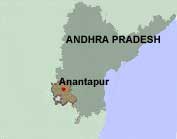<font class=UCASE><b>anantapur</b></font> <br> Nut case
 death is a seasonal visitor to Anantapur, Andhra Pradesh's largest district and wasteland. It comes just before sowing and after the harvest of groundnut, a cash crop that occupies 91 per cent of land in the district. More than 100 groundnut farmers have committed suicide since the last two years after getting caught in a debt trap. Totally dependent on rain fed agriculture, Anantapur's farmers are paying for the ecological devastation brought over decades, mostly by government policies. The district today howls for water.
death is a seasonal visitor to Anantapur, Andhra Pradesh's largest district and wasteland. It comes just before sowing and after the harvest of groundnut, a cash crop that occupies 91 per cent of land in the district. More than 100 groundnut farmers have committed suicide since the last two years after getting caught in a debt trap. Totally dependent on rain fed agriculture, Anantapur's farmers are paying for the ecological devastation brought over decades, mostly by government policies. The district today howls for water.
But water was never so scarce as it is now. With an average rainfall of 520 mm, its history is replete with one of India's finest water harvesting traditions. Some 5,000 tanks harvested enough water till the 1960s that sustained traditional agriculture. Till the 1970s, these tanks ensured prosperity. Legend has it that in the 15th-18th century, its local markets used to sell pearls and diamonds along with groundnuts and vegetables. From Ratnalasima (land of jewels) to Rallasima (land of rocks), Anantapur's poverty is government sponsored.
The death of tanks began when the government wrested control over the tanks from the villagers in the 1970s. With hardly any rainwater stored or recharged, groundwater levels went down from 33 metres in 1984 to 91 metres in 2000. The district loses a mind-boggling 1.9 tonnes of soil per hectare (ha) every year, according to a survey by the N G Ranga Agriculture University in Anantapur. Satellite images show that 54 per cent of the district's areas have lost soil cover. One million ha of land has lost its productivity, mostly agricultural lands.
The 1980s witnessed large-scale migration. The government stepped in with a range of poverty alleviation programmes. One of which was the
